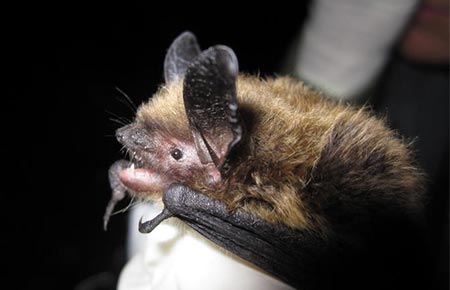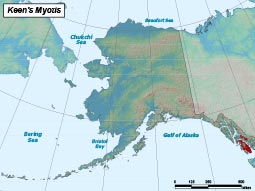Western Long-eared Bat
(Myotis evotis)
Species Profile
Did You Know?
Bats are in their own Order, called Chiroptera, meaning "hand-wing." This is due to their unique flight abilities with wing bones that are similar to those in human fingers.
General Description
The western long-eared bat, also known as long-eared myotis, is a medium-sized (wingspan 21-26 cm) insectivorous bat with dark silky brown fur and indistinct dark shoulder spots on the back. Their ear and flight membrane is dark, but not black. The ears are long enough to extend at least 4 mm beyond the tip of the nose when pressed forward. The tragus is long, upward pointing, and tapered at the end, in contrast with the short, blunt ended tragus of the little brown bat. The tragus is a fleshy projection that covers the ear canal, the entrance of the ear. (People have a tragus, too, but it doesn't play a role in echolocating as it does in bats). Because each species of bat has a different shaped tragus, this is a good way to identify them. The outside edge of the tail membrane has a fringe of tiny hairs, visible with a hand lens. The long-eared bat averages 9 cm in length and 8 grams in weight. Because of the relatively low number of M. evotis that have been captured in the wild, little information is known about their lifespan, but they have been documented to live up to 13 years.
Studies have shown that M. evotis prefer to roost in Cedar and Hemlock trees that have various degrees of decay and defects.
In recent years, bat researchers have determined that the species previously identified in Southeast Alaska, British Columbia and the Pacific Northwest as Keen's myotis (Myotis keenii), is now recognized to be the western long-eared bat (Myotis evotis). Looking at the genetics, morphology and acoustics, Keen's myotis is indistinguishable from the western long-eared bat.
Life History
Growth and Reproduction
Little is known about the breeding habits of long-eared bats. Limited evidence suggests that M. evotis mates in autumn and gives birth to a litter of one the following June or July.
Warm roost sites with stable microclimates are selected by females for day-roosting in temperate climates, which likely reduces the demands of thermoregulation. This assists reproductive females in fetal development and growth of juveniles by allowing reproductive females to avoid or reduce the use of torpor. Bats often enter torpor during inclement weather to conserve energy, but this delays juvenile and fetal development and inhibit milk production. Females provide milk and protection to their young until they become independent, usually by late August. Torpor occurs when M. evotis enters a decreased state of physiological activity by reducing their rate of metabolism and body temperature. Torpor can occur daily during winter months.
Feeding Ecology
Very little is known about this species. They are believed to be solitary and reported to fly rather slowly while foraging. Being nocturnal animals, bats sleep during the day and hunt and feed during the night on caddis flies, mayflies, leafhoppers, beetles, moths, lacewings, and spiders. The short duration of darkness during summer nights at high latitudes reduces foraging opportunities, thereby limiting the northern range of bats. M. evotis captures both flying prey in the air and by gleaning prey from surfaces. Studies have shown about half the M. evotis diet to consist of spiders, suggesting that this species is actively selecting their prey by gleaning rather than opportunistically hunting.
Migration
Migration for M. evotis occurs between summer maternity colonies/foraging areas and hibernacula (where bats hibernate).
Range and Habitat
The western long-eared bat is found in Southeast Alaska, western Canada, the Western U.S. and Baja, in Mexico. When formerly identified as the separate species, Keen's myotis, those bats were associated with coastal forest habitat, and mature forests, mostly in Southeast Alaska and western B.C. It was noted that "Myotis keenii had one of the most restricted distributions of any North American bat." Now that Keen's is recognized as the western long-eared bat, Southeast Alaska represents the northernmost portion of its range.
Southeastern Alaska's temperate rainforests contain abundant live trees and snags in a variety of sizes. Such structural diversity provides loose bark and tree hollows suitable for cavity roosting bats, suggesting that the temperate rainforests of southeastern Alaska provide structure required by M. evotis and other bat species. Caves and crevices are also important habitat for this species, and over 1,769 km² of cave and crevice-containing karst occurs throughout southeastern Alaska.
Status, Trends, and Threats
Status
- NatureServe: Global — G5 (Widespread distribution in western North America; many occurrences in wide range of habitats; occurs regularly in low numbers across range; uses wide range of often plentiful roost sites; trend uncertain but probably relatively stable or slowly declining; no known major threats, but range, habitats, and threats during winter are poorly known.)
- IUCN: LC (least concern)
Trends
Statewide trends in population numbers are unknown, but presumably is at least several thousand. A maternity colony in British Columbia included about 40 reproductive females.
Threats
The distribution of M. evotis in Southeast Alaska is associated with coastal rainforests. Forty-two percent of the most productive forests in southeast Alaska were harvested by 1990, including more than seventy percent of the karstland forests on Prince of Wales and neighboring islands. Current levels of timber harvest could have a detrimental effect on the Alaska population by altering forest structure important to bats. Bat activity is rare in clearcuts and second-growth forests of Southeast Alaska. Destruction of karst by recreationalists or mineral extraction may be a threat, as these areas are critical hibernacula.
Fast Facts
-
Size
Length: 9 cm
Weight: 8 g
Wingspan: 21–26 cm -
Range/Distribution
Temperate coastal forests of Southeast Alaska -
Diet
Flying insects -
Predators
There are no documented predators of this species. It is likely the same animals that prey upon the little brown bat also take long-eared bats, such as owls, hawks, cats, or raccoons (outside Alaska). -
Reproduction
Only one litter, usually of a single pup, is produced per year.


